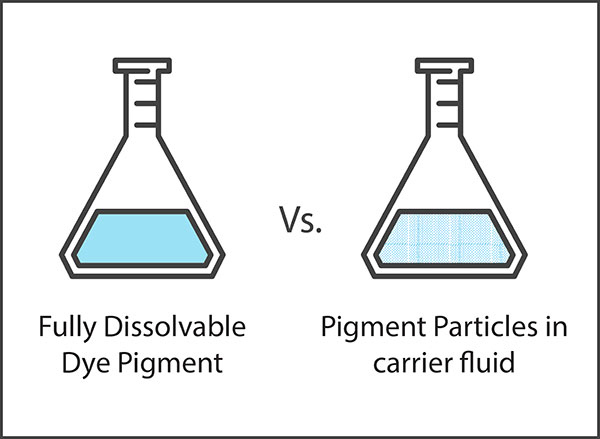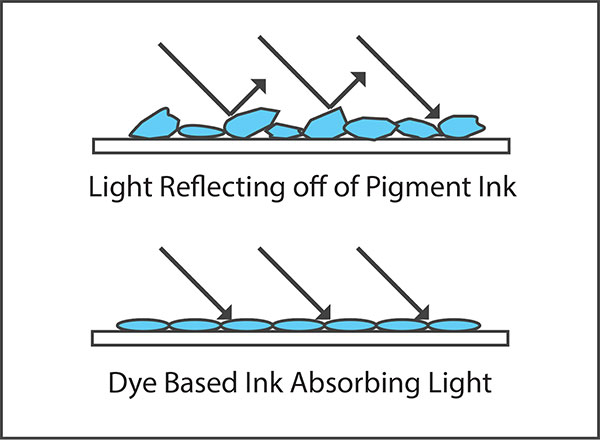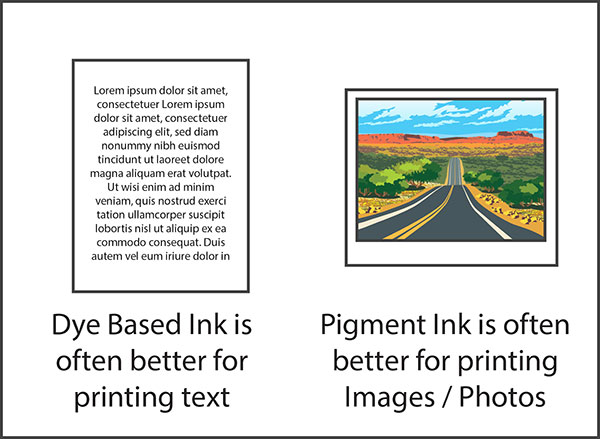Pigment Vs Dye Ink: Battle Of The Inks 2021
When it comes to printing your professional and personal materials, there’s more to consider beyond what size and stock. The type of ink you use can significantly impact your output. From highlighting the wrong elements to missing the mark when it comes to delivering the right impact, choosing wisely; is wise.
In this short guide, we're taking a look at pigment ink vs dye ink and uncovering key factors that may influence your decision. Read on become to become an expert within just a few minutes.
Pigment Vs Dye Ink Summary:
To the naked eye, you would be forgiven for thinking there was little difference between pigment and dye-based inks. It's only when you closely compare pigment vs dye ink that you will be able to identify which ink is responsible for which output. In summary, pigment-based ink, although not as vibrant with colours is best suited to photo printing. This is due to it's advanced strengthening to sunlight and also the longevity of the ink on certain paper types.
As for dye-based ink, this is predominantly used for text-based creations and sharper prints. Dye-based ink will smudge much easier than pigment ink, however, will deliver much more vibrance in colour. For the time-poor, here is a quick summary of the pros and cons of pigment vs dye ink.
- Pigment ink delivers longevity.
- Pigment ink is better prepared for sunlight.
- Pigment ink works better with glossy paper.
- Pigment ink has less smudging potential.
- Dye ink produces vibrant colours.
- Dye ink is cheaper than pigment ink.
Now, let's delve deeper into the differences between pigment ink and dye-based ink. Albeit very subtle with modern technology, there are still certain circumstances where you may want to choose one of the other.

What is pigment ink?
Pigment-based inks are made up of a collection of solid particles that come from pigment powder. Comparatively to dye-based inks, the solid particles of pigment-based inks result in less smudging and longer-lasting presence. As such, pigment inks are perfect for documents (especially photos) that will be kept in an archive for a considerable amount of time.
In addition, the smudge less nature of pigment-based inks results with perfect printing on slicker surfaces like glossy paper. However, just like anything fancy in this world, pigment inks are more expensive to purchase than their dye-based counterparts. They are also, unfortunately, not as vibrant in colour.
What is dye ink?
Since the beginning of inkjet printers, dye-based inks have been around. Using a dye dissolved in water, along with various optical compounds, dye-based inks create a bright and vibrant colour on the page. They also result in sharper text fonts too. However, due to the thinner and less durable nature of dye-based inks, they will fade rather quickly when exposed to too much sunlight. There is also that issue of smudging as the water-based components take longer to dry on the paper.
While this may rule dye-based inks out for those who want quick and quality prints, dye-based inks have improved significantly over the years and are catching up fast to their counterpart in pigment-based ink. Manufacturers such as HP & Epson are even using both pigment and dye-based inks together to formulate the ultimate combination of both durability and colour.

Difference between pigment and dye ink?
When it comes to the difference between pigment and dye ink, there is very little to separate the two ink bases. Technology improvements have resulted in the flaws of both types of inks becoming almost impossible to notice, however, they do still exist.
Let's take a look at what separates dye and pigment inks.
1. Water Resistance
Unless you laminate your prints, unfortunately, there is no such thing as everyday water-proof printing. However, choosing well between dye ink and pigment ink may just save your week. In short, dye-based ink will dissolve entirely within the water. Should you spill water on your dye printed paper, the ink will flow and transform your incredibly boring financial document into beautiful artwork. However, upon drying completely, do not expect everything to be back to where it was previously.
Conversely, pigmented inks stick to the paper as they have a thicker consistency which nestles into the small fibres of the page. This means that, overall, pigmented inks have greater water resistance. Although, curiously, dye-based inks have been the standard offering for inkjet printers which are renowned for better quality photo printing. This goes to show that the technology behind both dye-based ink and pigment-ink has improved significantly over the years.
2. Print Fading
Similarly to spilling water all over your artwork, the last thing you want is for your prints to fade into oblivion. Both direct and indirect factors can cause your prints to fade with sunlight being the greatest offender. In this regard, dye-based inks are more susceptible to fading as the molecules are smaller on the page. As such, the chemicals react with sunlight a lot faster and with accelerated damage.
On the contrary, pigment inks are made up of larger molecules which makes penetrating the work harder for sunlight. That said, both inks are high-quality solutions and you would have to really try hard to completely fade your work. Both inks will last in their original condition for a very long period of time.
3. Overall Printing Quality
For overall printing quality when comparing pigment vs dye ink, there is no clear winner. In fact, the question is not about overall printing quality but rather what are you going to be printing and with what colours. If you are printing text-based creations then a dye-based ink will be the right selection. The reason for this is because the black print is a lot sharper and darker than pigmented ink. In addition, dye-based ink can also result in other colours presenting more vibrantly.
Conversely, pigmented ink is best used to blend colours. There is nothing that can match custom pigment ink for colour depths and blends. As such, this is typically the go-to ink for photo printing. However, technology is closing the gap between both inks and most printers will facilitate both pigmented and dye-based inks to create the highest standard of printing.
4. Cost Differences
Of course, price is always a strong driver for decision making. For the best pigment ink, you will be looking at spending more than dye-based inks. This is because the complex process of producing pigmented inks requires more labour time which has a cost. Custom pigmented inks are highly regarded for their ability to blend colours more immersively. This makes for them to be well sought after, but also more expensive.

Choosing between dye or pigment ink for photo printing?
Professional and hobbyist photographers are more inclined to choose pigment-based inks due to the consistency of colour that can be achieved. Despite dye-based inks producing slightly more vibrance, the blend and consistency of colour are what makes for a truly stunning photo. For the absolute best of the best, you will want to purchase a custom pigment ink that will also serve the test of time.
As a hardier based ink, pigment ink will also not succumb to fading from sunlight very easily. This results in your print looking newer for longer. There is, however, the cost. Should you really care about your printing then custom pigment inks will cost a pretty penny. As such, you may look to find a solution for dye-based inks that still delivers the vibrance that you need; without the payday loan.
Should you find yourself choosing between dye or pigment ink for photo printing, you should also read our comprehensive guide on inkjet vs laser printers. The difference between the two printers will have a significant impact on your printing outcomes. In particular, long term cost savings.
Dye Vs Pigment Ink Roundup:
Armed with the knowledge of which ink performs best for each circumstance, you should now be better prepared to select the ink type that will deliver the greatest outcomes. If you find yourself printing photos and colour dominant documents, pigment ink will afford you a more vibrant palette. Conversely, longer-lasting text-based documents are best suited when printed with dye-based ink.
Remember though, ink technology has significantly improved over the years and you will likely find that your printer uses a combination of pigment-based ink and dye-based inks. Therefore, we would not be too concerned should you have not read this article before purchasing your ink type. Just be sure to pay attention to considerations such as sun exposure and opportunities for smudging.
Should you have any questions, feel free to head on down to our comments section or speak to us via live chat. We would be more than happy to assist you in choosing the right printer and ink for your needs.
Explore Popular Articles
-
How To Disable Firmware Updates For HP Printers
13th Feb 2024There are a few notable reasons why printer manufacturers produce their own branded printer ca
-
Top 5 Best Printers For Artists In 2024
13th Feb 2024Our home and office printers can actually be pretty versatile machines. Alongside being able to p
-
Top 5 Best Scanners For 2024
13th Feb 2024More often than not, we only realise how invaluable printer features are until we actually start




